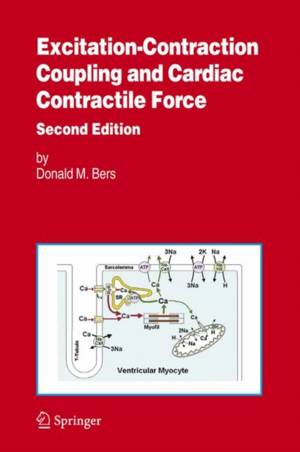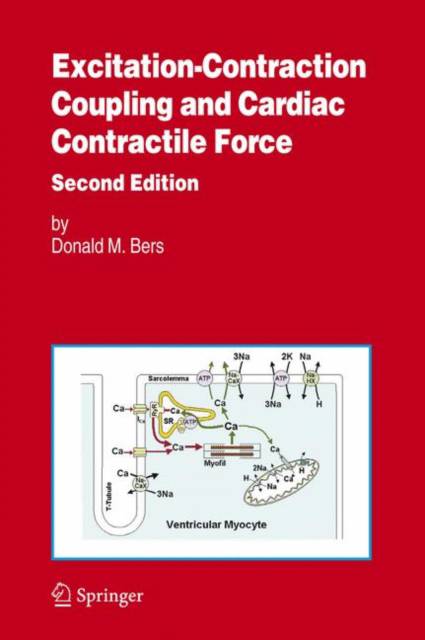
- Afhalen na 1 uur in een winkel met voorraad
- Gratis thuislevering in België vanaf € 30
- Ruim aanbod met 7 miljoen producten
- Afhalen na 1 uur in een winkel met voorraad
- Gratis thuislevering in België vanaf € 30
- Ruim aanbod met 7 miljoen producten
Zoeken
Excitation-Contraction Coupling and Cardiac Contractile Force
Donald Bers
€ 153,95
+ 307 punten
Uitvoering
Omschrijving
How is the heartbeat generated? What controls the strength of contraction of heart muscle? What are the links between cardiac structure and function? How does our understanding of skeletal and smooth muscle and non-muscle cells influence our thinking about force development in the heart? Are there important species differences in how contraction is regulated in the heart? How do the new molecular data fit together in understanding the heart beat? What goes wrong in ischemia, hypertrophy, and heart failure? This book paints a modern `portrait' of how the heart works and in this picture the author shows a close-up of the structural, biochemical, and physiological links between excitation and contraction.
The author takes the reader through a series of important, interrelated topics with great clarity and continuity and also includes many useful illustrations and tables. The book starts by considering the cellular structures involved in excitation-contraction coupling and then described the characteristics of the myofilaments as the end effector of excitation-contraction coupling. A general scheme of calcium regulation is described and the possible sources and sinks of calcium are discussed in simple, but quantitative terms. The cardiac action potential and its many underlying currents are reviewed. Then the characteristics of some key calcium transport systems (calcium channels, sodium/calcium exchange and SR calcium uptake and release) are discussed in detail. This is then built into a more integrated picture of calcium regulation in succeeding chapters by detailed discussions of excitation-calcium coupling mechanisms (in skeletal, cardiac, and smooth muscle), the interplay between calcium regulatory processes, and finally mechanisms of cardiac inotropy, calcium overload, and dysfunction (e.g., ischemia, hypertrophy, and heart failure).
Excitation-Contraction Coupling and Cardiac Contractile Force &endash; Second Edition is an invaluable source of information for anyone who is interested in how the heart beat is controlled and especially suited for students of the cardiovascular system at all levels from medical/graduate students through senior investigators in related fields.
The author takes the reader through a series of important, interrelated topics with great clarity and continuity and also includes many useful illustrations and tables. The book starts by considering the cellular structures involved in excitation-contraction coupling and then described the characteristics of the myofilaments as the end effector of excitation-contraction coupling. A general scheme of calcium regulation is described and the possible sources and sinks of calcium are discussed in simple, but quantitative terms. The cardiac action potential and its many underlying currents are reviewed. Then the characteristics of some key calcium transport systems (calcium channels, sodium/calcium exchange and SR calcium uptake and release) are discussed in detail. This is then built into a more integrated picture of calcium regulation in succeeding chapters by detailed discussions of excitation-calcium coupling mechanisms (in skeletal, cardiac, and smooth muscle), the interplay between calcium regulatory processes, and finally mechanisms of cardiac inotropy, calcium overload, and dysfunction (e.g., ischemia, hypertrophy, and heart failure).
Excitation-Contraction Coupling and Cardiac Contractile Force &endash; Second Edition is an invaluable source of information for anyone who is interested in how the heart beat is controlled and especially suited for students of the cardiovascular system at all levels from medical/graduate students through senior investigators in related fields.
Specificaties
Betrokkenen
- Auteur(s):
- Uitgeverij:
Inhoud
- Aantal bladzijden:
- 427
- Taal:
- Engels
- Reeks:
- Reeksnummer:
- nr. 237
Eigenschappen
- Productcode (EAN):
- 9780792371588
- Verschijningsdatum:
- 31/08/2001
- Uitvoering:
- Paperback
- Formaat:
- Trade paperback (VS)
- Afmetingen:
- 158 mm x 234 mm
- Gewicht:
- 657 g

Alleen bij Standaard Boekhandel
+ 307 punten op je klantenkaart van Standaard Boekhandel
Beoordelingen
We publiceren alleen reviews die voldoen aan de voorwaarden voor reviews. Bekijk onze voorwaarden voor reviews.








